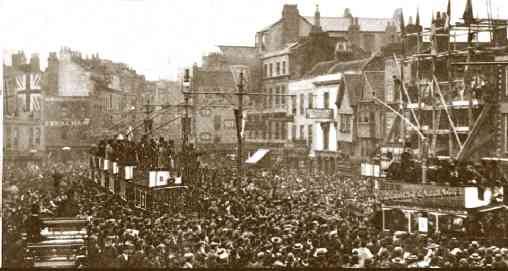Bristol Tramways & Carriage Co
Bristol Tramways 14 Aug 1895 to 11 Apr 1941
This section is based in its entirety on Peter Davey’s book “Bristol’s Tramways” – a remarkable photographic record of the period 1895-1941. Both words and pictures used are derived from it as extracts and summaries. The book contains over 120 photographs.
|
|
History
The first trams in Bristol were pulled by horses commencing on 9th August 1875 running from Perry Road (Colston Curve) to Apsley Road, known as Redland Terminus. The horses were kept at the Colston Stables, wedged between the triangle of Perry Road, Colston Street and Griffin Lane (now Lower Park Row).

Peter Davey’s Collection
On 14th October 1895, the first electric cars ran from Old Market to Kingswood and were kept at the depot in Beaconsfield Road, St. George, which was also the power station.
Eventually 17 tram routes existed which were reduced to 12 in thc final pattern. (The first bus route was 18).
In 1900/01 the largest depot, workshop and maintenance complex was built at Brislington and it was used for the construction of trams. Later many of the City’s buses were built and housed there. It still exists (a listed building) and some of the tram tracks are still down in the old engineering shops at the far end.

The fleet commenced with various horse trailers, totalling 109 with 678 horses. These were eventually replaced by electric cars which totalled 237. The last new batch was built in 1920 to the same basic open top design and style as those of twenty years before. With a few exceptions all cars were rebuilt as the “standard” car through the 1920s and 1930s.
Details of the Generating stations employed by the Bristol Tramways and Carriage Co. are available in Histelec Supplement No.30
Horse tram routes
- Drawbridge – Perry Road – Redland (Apsley Road)
- Drawbridge – Horfield Depot
- Drawbridge – Cumberland Street – Ashley Road – Warwick Road
- Hotwells (Dowry Square) – Drawbridge – Joint Station
- Bristol Bridge (Redcliffe Street) – Ashton Gate (Coronation Road)
- Bristol Bridge (Redcliffe Street) – Bedminster Old Market – Bath Street – Joint Station – Totterdown – Arno’s Vale
- Old Market – Peny Road – Redland (Apsley Road)
- Old Market – Eastville
- Old Market – St. George – Kingswood
“Drawbridge” was later discontinued and “Tramways Centre” substituted. |
Track Layout

Click on map above to see full version!
Electric tram routes
The routes were not numbered until November 1913 and were as follows –
- Tramways Centre – Whiteladies Road – Durdham Downs
- Tramways Centre – Whiteladies Road – Durdham Downs – Westbury
- Eastville – Old Market – Whiteladies Road – Durdham Downs
- Tramways Centre – Zetland Road – Durdham Downs
- Tramways Centre – Ashley Down Road – Horfield Barracks
- Tramways Centre – Ashley Down Road – Horfield Barracks – Filton Park – Filton
- Tramways Centre – Warwick Road – Eastville – Fishponds
- Tramways Centre – Temple Meads Station
- Hotwells – Tramways Centre – Temple Meads Station – Arno’s Vale – Depot – Brislington
- Bristol Bridge – Knowle
- Bristol Bridge – Ashton Road
- Bristol Bridge – Bedminster Depot – Bedminster Down
- Tramways Centre – Old Market – St. George – Whiteway Rd – Kingswood
- Zetland Road – Old Market – Eastville – Fishponds – Staple Hill
- Knowle – Bushy Park – Old Market – St. George – Marling Road – Nags Head Hill – Hanham
- Old Market – St George
- Hotwells – Tramways Centre – Temple Meads Station
- Route 1 was withdrawn and absorbed into 2.
- Route 8 was withdrawn and absorbed into 9.
- Route 13 for a while, did not run to the Tramways Centre but terminated at Old Market.
- Route 16. was a “rush hour” route only and was absorbed into 13 and 15.
- Route 17 ran to meet the Campbell’s steamers and was withdrawn at the same time as route 8.
Trams did not actually run along Ashley Down Rd., Marling Rd., or Whiteway Road, and route 14 did not enter Zetland Rd.
From 1902 to 1905, the route from Hanham. having reached Old Market, was extended to the Tramways Centre. |
Nighttime in Old Market

A.B.Bishop
|
Abandonment commenced in 1938 and was to be carried out in five phases, but during an air raid on Good Friday 1941, bombs dropped on St Philip’s Bridge outside the power station and disrupted the system’s electricity supply. Buses immediately appeared, unplanned, the next morning. During the next few weeks the powerless cars had to be towed to Kingswood to face their sad cremation. The last one to disappear in the flames was car 64 on 16th October 1941
The Last Few Moments Of Car 205

S.Miles Davey
|
|

Prior To Opening Electric First Tramway
Old Market – Kingswood 1895

M.J.Tozer Collection
| A few days before the Old Market – St.George – Kingswood Electric Line was opened, cars 89 and 92 are seen just delivered from Milnes, Birkenhead. The Scene is at St.George and no doubt various tests are being carried out. Car 92 has yet to be fitted with her lamps but she illustrates the seeming awkwardness of the Dick Kerr trolley masts. |
|
Also see our Bristol Tramways Power Stations page and our other pages on Electric Transport in the South West






